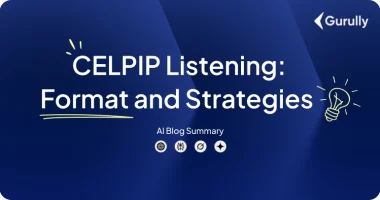To score high in CELPIP, you must ace all the sections of this exam. This exam is divided into 4 sections: reading, writing, listening, and speaking, and out of these sections, most of the students find listening a bit difficult. So, to make the preparation smoother, here is a detailed guide for the CELPIP listening format.
CELPIP Listening Format is designed to test how comfortably you handle English in everyday situations. And it is also considered to be one of the most important parts of the CELPIP exam. The entire section is around 47-55 minutes and is divided into various tasks. Let’s walk through each part in a way that makes sense for someone preparing seriously for the test.
| Part | Frequency of Questions (Approx.) | Time Duration (Approx.) |
| Practice Task (unscored) | 1 | 1 Minute |
| Part 1: Listening to Problem Solving | 8 | 8 Minute |
| Part 2: Listening to a Daily Life Conversation | 5 | 5 Minute |
| Part 3: Listening for Information | 6 | 6 Minute |
| Part 4: Listening to a News Item | 5 | 5 Minute |
| Part 5: Listening to a Discussion | 2 | 9 Minute |
| Part 6: Listening for Viewpoints | 6 | 8 Minute |
Tasks in CELPIP Listening Format
Practice Task (Unscored)
Before the real scoring begins, you get a quick warm-up where you’ll hear a brief audio clip — usually just a simple sentence or short exchange. This isn’t graded, but it helps you get used to the volume, pace, and overall environment.
It’s useful for adjusting your mindset: you get a feel for Canadian pronunciation, pacing, and conversational rhythm without consequences.
Part 1 – Listening to Problem Solving
This is a first-scoring section in which you will hear a conversation between two people, one male and one female. The audio will be in 3 sections of around 1-1.5 minutes. After each audio, there will be 2-3 questions, and you will have 30 seconds to listen and answer the questions.
Topics of conversation:
- Someone is asking for a direction.
- One person seeking help with some chore.
- Issues with a product or service.
- A person seeking suggestions or help.
What the test wants to measure:
In this task, your ability to comprehend practical information, such as numbers, timings, prices, or the steps needed to fix something, is evaluated. It is advised to use polite and indirect phrasing.
Part 2 – Listening to a Daily Life Conversation
In this task, you will hear a single audio of two people, one male and one female, involved in a conversation. The audio clip will be around 1.5 to 2 minutes. You have to answer the questions asked about the audio.
Topics of conversation:
- A couple planning an outing.
- Coworkers discussing an office task.
- Friends talking about an event, appointment, or favour.
- Someone sharing personal experiences.
What the test wants to measure:
In this task, your understanding of natural and casual communication about opinions, hints, everyday expressions, etc., is evaluated. As the conversation between two people is natural and not structured, try to track the points carefully.
Part 3 – Listening for Information
In this task, you’ll hear an audio of around 2 to 2.5 minutes, where one person is providing clear and structured information. It’s often similar to listening to instructions or guidance.
Topic of Conversation:
- A manager explaining a procedure.
- A service representative describing how something works.
- Someone giving step-by-step instructions.
- A student asking questions about a class or assignment.
What the test wants to measure:
In this task, how well you gather explanations, information, sequencing, and clarification is evaluated. The conversation can be information-heavy. If your attention slips for even a few seconds, you may miss the key detail the question is based.
Part 4 – Listening to a News Item
This section switches into a one-speaker format. You’ll hear a short news-style report, similar to what you might hear on a radio update or an online news clip in audio format of about 1.5 minutes.
What you typically hear:
- Community events.
- Local incidents.
- Announcements.
- Public service information.
What the test wants to measure:
News reading is clear and structured. This part tests your ability to understand factual information, identifying causes and important statistics. The news voice does not repeat information. The details are often packed tightly, so you must absorb them quickly.
Part 5 – Listening to a Discussion
In this CELPIP listening task, you will see a video clip of about 1.5 to 2 minutes. The video will be of 3 speakers discussing any point.
Discussion topics can be about:
- Deciding on how to organize an event.
- People sharing their opinions on the event.
- Comparison of different topics.
- People reacting to each other’s ideas.
What the test wants to measure:
As there are multiple voices, in this task, your ability to identify and understand who is talking about what is evaluated. You will be scored on your ability to decode and track ideas, agreements, or suggestions. As the discussion is not structured so stay alert to tone and shifts of topics.
Part 6 – Listening for Viewpoints
In this task, there will be an audio clip of around 3 minutes in which a speaker will talk about any topic and what can be done.
Topics of discussion:
- Experience with a community project.
- Addressing a social issue.
- Feedback about any event.
- An analysis of a situation involving judgments and reasoning.
What the test wants to measure:
In this task, how well you understand opinions vs. facts, reasoning, and justification is evaluated. As the audio clip has layers, make sure you correctly identify facts, feelings and conclusions.
CELPIP Listening Practice Tips
Know the Test Format:
- Get familiar with all six Listening parts so you know what type of audio and questions to expect.
Practice Listening Once
- Train yourself to capture meaning in a single attempt since CELPIP audio doesn’t repeat.
Keep Notes Simple
- Use brief keywords and symbols to track main ideas, opinions, and important details.
Identify Speakers Clearly
- Note who says what in dialogues, as many answers depend on tracking each speaker’s viewpoint.
Notice Tone and Attitude
- Pay attention to emotion, hesitation, or emphasis to understand what the speaker really means.
Build Inference Skills
- Focus on what is implied rather than waiting for exact matching words from the audio.
Improve Vocabulary Through Audio
- Listen to news, podcasts, and everyday conversations to strengthen recognition of common phrases.
Do Timed Practice
- Work through sections under real exam timing and review errors to sharpen accuracy.
Things To Avoid While Attempting the CELPIP Listening Test Format
- Don’t wait for exact wording from the audio; CELPIP uses paraphrasing.
- Don’t write long notes that distract you from ongoing details.
- Don’t ignore tone or attitude, as many answers depend on it.
- Don’t overthink after the audio ends; go with the most logical choice.
- Don’t skip any question since there’s no penalty for guessing.
Start working toward your target score by taking a full-length mock test on Gurully. Each test is designed by experienced exam specialists, so you get a clear feel for how the actual exam is structured. The platform mirrors the real test environment, which makes your practice more meaningful and builds your confidence. Once you finish a CELPIP mock test, you get instant AI-based scoring that helps you understand exactly where you stand and what to improve next.
FAQ:
Is 7 a good score in CELPIP?
Is CLB 7 B2 or C1?
Is CELPIP harder than IELTS?
How much is 9 in CELPIP equivalent to IELTS?
Which English test is better for Canada PR?
Also Read:
- Is CELPIP Valid for Australia? Facts Every Applicant Should Know
- CELPIP Vocabulary: Learn 150+ Words To Score High
- CELPIP Writing Format Guide With Sample Question & Answer For 2026







